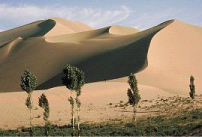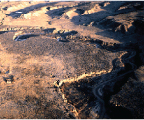|

COMPARE DIFFERENT TYPES OF DESERTIFICATION.
As you learned in lesson 4, deserts are areas that get very little rainfall. However, there are various causes of desertification—the damage to land that creates deserts. Some desertification has already occurred over long periods of time; more desertification occurs in modern times. You may not have realized that Antarctica is the largest desert on Earth. The Sahara is the next-largest desert and it is the one we usually think about when we talk of deserts, since it is hot and sandy there. Some deserts occur because of high mountain ranges that block precipitation. Others occur in the middle of continents because the winds can't carry water far enough inland; for example, the Gobi Desert is in the interior of the Asian continent. The Gobi is mostly a rocky desert with mountains, plateaus, and some sandy areas. In the summer the Gobi can get hot like the Sahara; sometimes the temperature can reach as high as 113º F. However, in the winter the Gobi might seem more like Antarctica since it can get as cold as -40ºF. The common thread among desert regions is a lack of rainfall which results in little vegetation. Since Antarctica's surface is covered with a coat of ice that never melts, it is not subject to the forces of erosion in quite the same way as other deserts. The rock and soil of most deserts of the world are continually eroding. Much of the erosion is caused by wind, but water erosion also occurs and is often the most dramatic type of desert erosion. Since there is little vegetation in deserts, heavy rainfall can quickly wash away large areas, creating holes and gullies. Wind and water erosion, as well as human and animal activities, can lead to desertification. To learn more about desertification, read the following information that is taken from the United States Geological Survey.
The world's great deserts were formed by natural processes over long periods of time. During most of these times, deserts have grown and shrunk independent of human activities. Some large sand seas are not really deserts anymore because they are now stabilized by vegetation. These areas extend well beyond the present deserts, such as the Sahara. In some regions, deserts are separated sharply from surrounding areas by mountains and other landforms. In other areas, the change is a gradual shift from dry to more humid environments; in these areas it is difficult to define the desert border.
Along these border zones, the ecosystems are very fragile and delicately balanced; they are easily damaged by human activities. For instance, damage can be caused by livestock herds as their hooves pound the soil, which then makes the soil more likely to be eroded by wind and water. Grazing and the collection of firewood also reduces or eliminates vegetation that helps to hold the soil in place. The process of desertification became well known in the 1930s when parts of the Great Plains in the United States turned into the Dust Bowl. During the Dust Bowl period, millions of people were forced to abandon their farms and livelihoods. Greatly improved methods of agriculture and land and water management in the Great Plains have prevented this disaster from recurring, but desertification still affects millions of people on almost every continent.  
|
About Us | Terms of Use | Contact Us | Partner with Us | Press Release | Sitemap | Disclaimer | Privacy Policy
©1999-2011 OpenLearningWorld . com - All Rights Reserved




